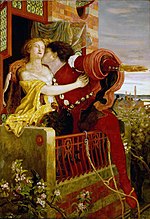Dieses Wiki, das alte(!) Projektwiki (projektwiki.zum.de)
wird demnächst gelöscht.
Bitte sichere Deine Inhalte zeitnah,
wenn Du sie weiter verwenden möchtest.
Gerne kannst Du natürlich weiterarbeiten
im neuen Projektwiki (projekte.zum.de).Themes: Unterschied zwischen den Versionen
(→Love) |
|||
| Zeile 2: | Zeile 2: | ||
== Love == | == Love == | ||
| − | [[File:Romeo and juliet brown.jpg| | + | [[File:Romeo and juliet brown.jpg|150px|thumb|An 1870 oil painting by Ford Madox Brown depicting the play's famous balcony scene]] |
The most dominant theme by far is the theme of young romantic love. | The most dominant theme by far is the theme of young romantic love. | ||
The two young lovers experience love at first sight, which is violent, ecstatic, and an overpowering force over their lives. This overpowering love drives them to defy both their families and friends in order to stay together. | The two young lovers experience love at first sight, which is violent, ecstatic, and an overpowering force over their lives. This overpowering love drives them to defy both their families and friends in order to stay together. | ||
Version vom 25. September 2018, 10:58 Uhr
While "Romeo and Juliet" is most popular for its portrayal of the theme love, the play also includes other themes, which are worth talking about.
Love
The most dominant theme by far is the theme of young romantic love. The two young lovers experience love at first sight, which is violent, ecstatic, and an overpowering force over their lives. This overpowering love drives them to defy both their families and friends in order to stay together.
Throughout the play, Shakespeare succeeds not only in portraying the chaos and passion of young love, but also the connection between love and violence. The relationship of Romeo and Juliet has been linked to death since the very beginning. From that point on, love pushes them closer to violence instead of farther away from it, until the only solution seems to be double suicide.
Shakespeare describes love as amoral,leading to both destruction and happiness because of the extreme passion that comes with it.
Fate and Chance
Even though experts haven't agreed upon whether the tragic death of the protagonists was fate or just a series of unfortunate coincidences, the description of the young couple as "star-cross'd" seems to imply fate. It suggests that the future of them has been predetermined by the stars, which were believed to control fate.
As Romeo swears his love to Juliet by the moon she protests, suggesting that the moon is inconsistend and changes monthly. With this, Shakespeare also introduces the theme of time in regards to fate. The movement of the stars, influenced by time, is believed to change fate.
Duality of Light and Dark
Throughout the whole play, Shakespeare uses imagery of light and dark, which can be interpreted as symbols for e.g. love and hate or youth and age. Both Romeo and Juliet describe each other as a source of light in an otherwise dark environment. This symbolism is apparent until the tragic end; Romeo describes Juliet's beauty as making "This vault a feasting presence full of light." even as he thinks that she's dead.
Sources: sparknotes.com, www.myenglishpages.com


